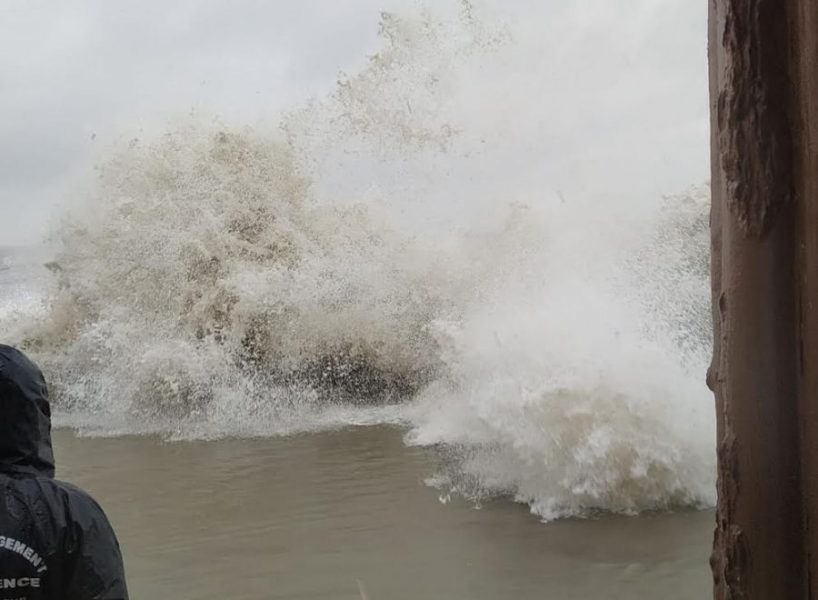
Taming the waves: How technology can make a difference
From being caught off guard when the devastating 1977 cyclone hit its coast, claiming over 10,000 lives, to becoming the first state in the country to use space technology for disaster management, Andhra Pradesh has come a long way

From being caught off guard when the devastating 1977 cyclone hit its coast, claiming over 10,000 lives, to becoming the first state in the country to use space technology for disaster management, Andhra Pradesh has come a long way.
The authorities were totally unprepared when Diviseema, a cluster of island villages in Krishna district, were wiped out in the worst calamity in the state’s history. Ironically, in terms of severity, the 1977 cyclone was nowhere close to ‘Hudhud’ cyclone that hit the Andhra coast in 2014. But, the improvements in weather forecasting and disaster preparedness made all the difference. Data collection of the past few decades has made climate models more precise and accurate.
The death toll in the Hudhud cyclone stood at 50, though it left a trail of far greater destruction, causing severe damage to the coastal infrastructure.
Andhra Pradesh’s expertise in disaster management was sought by neighbouring Odisha during the 1999 super cyclone. In 1999, the preparedness of the Odisha government was poor. “Andhra Pradesh was better prepared and helped Odisha overcome the disaster situation. Odisha did not even have instruments to cut trees that fell on the roads,” says former vice-chairman of the National Disaster Management Authority (NDMA) M Shashidhar Reddy. The ham radio network was virtually non-existent in Odisha.
Also read: Revisiting Amphan’s predecessor, the Super Cyclone of 1999
Technology comes to the rescue
A combination of advancements in weather monitoring technology, preparedness and coordination with disaster mitigation and defence personnel had helped Andhra Pradesh and Odisha to minimise the human loss in the 2013 ‘Phailin’ and the 2014 ‘Hudhud’ cyclones.
The Hyderabad-based, Indian National Centre for Ocean Information Services (INCOIS) played a key role with its technology inputs, which included satellite imagery, wave, wind speed and potential rainfall data.
Learning from the havoc of the 1999 super cyclone, the IMD and other meteorology agencies, built up infrastructure like a network of satellite, ocean and ground-based technological tools to improve accuracy of forecasts.
Ahead of the approach of the Hudhud cyclone, which battered Visakhapatnam and several coastal districts in the two States with winds reaching 200 kmph and heavy rains wrecking much economic loss, people were moved to safe places and provided relief. The impact was so high that the radars and the weather stations in the area also got affected.
The Wave Rider Buoys and Automatic Weather Stations (AWS) deployed in Visakhapatnam and Gopalpur by INCOIS got the real time sea and weather related information.
Both Andhra Pradesh and Odisha, which perennially face the threat of natural disasters like cyclones and floods, have been improving their forecast and relief-cum-rehabilitation infrastructure.
A series of Doppler Radars, weather stations, ocean-based buoys and tracking systems were set up.
The Andhra Pradesh Government’s initiative to use crowd sourcing, by seeking pictures on the cyclone’s impact, contributions for a specially designed Website on the National Remote Sensing Centre through an Android app, a Facebook page and optimally utilising the imagery from the Centre, has also brought in encouraging response to improve administrative steps in handling natural disasters.
The crowdsourcing project allowed people to upload pictures and videos of the breached roads, damaged crops and inundated areas during Hudhud cyclone.
The uploaded pictures were automatically integrated with NRSA data to help the government in assessing the damages and mobilising required men and material to reach to the last point and also in undertaking rescue and relief operations in an efficient manner.
Web-based system
The officials say that the restoration of basic services in the shortest possible time after these Cyclones could be attributed to the State’s capability in disaster preparedness and response.
It is being done through development of a web-based Early Warning Dissemination System developed under World Bank aided National Cyclone Risk Mitigation Project (NCRMP) based on radio, satellite, internet and mobile technologies with each supplementing the other without breakup of communication to the last mile.
There are over 1,100 cyclone shelters along the Andhra coast, which have proved to be an important element of disaster resilience.
The idea of a structurally engineered public cyclone shelter was implemented for the first time in India in 1977 in the aftermath of the Diviseema cyclone. This led to conception of ‘Multi-Purpose Cyclone Shelters’ (MPCS) or their regular use as community centres and schools to ensure periodic maintenance.
A hazard risk vulnerability atlas has been developed on a web-based model for all the coastal districts.
Also read: Prone to floods and landslides, Kerala has no warning system to avert tragedies
Violation of environmental laws
The experts warn that while improvements in forecasting capabilities, preparedness and disaster management may have helped in mitigating the impact of cyclones, the indiscriminate denudation, in defiance of environmental laws, has rendered the coastal areas vulnerable to high-velocity cyclones.
The Coastal Regulation Zone requirements are indispensable for protecting the coastal and marine environment. The CRZ prohibits mechanical pumping of water through bore wells within 500 metres from the high tide line since it will cause saline sea water to contaminate the groundwater aquifers.
“This rule is wantonly breached,” says retired IAS officer and environmental activist E A S Sarma.
Post-1977, the state had set up a Coastal Zone Management Authority with its counterpart institutions in each coastal district. These institutions have become defunct now. “They need to be revived and adequately equipped and empowered. The same is the case with the state and district disaster management authorities,” he said.

